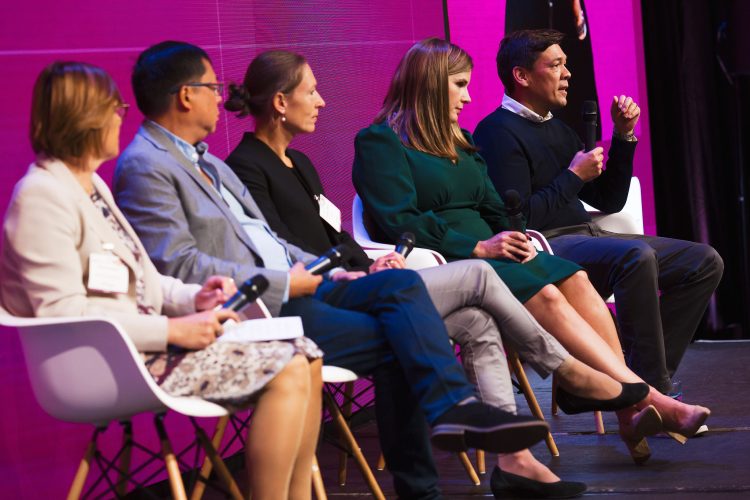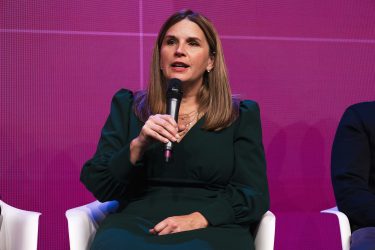Will technology save us from a food security catastrophe?
- Like
- Digg
- Del
- Tumblr
- VKontakte
- Buffer
- Love This
- Odnoklassniki
- Meneame
- Blogger
- Amazon
- Yahoo Mail
- Gmail
- AOL
- Newsvine
- HackerNews
- Evernote
- MySpace
- Mail.ru
- Viadeo
- Line
- Comments
- Yummly
- SMS
- Viber
- Telegram
- Subscribe
- Skype
- Facebook Messenger
- Kakao
- LiveJournal
- Yammer
- Edgar
- Fintel
- Mix
- Instapaper
- Copy Link
Posted: 30 September 2022 | Bethan Grylls (New Food) | No comments yet
New Food’s Bethan Grylls reports on the expertise aired at Future Food-Tech last week, as the global panel looked to answer whether technology can prevent us from the on-coming food security disaster.


The expert panel set to answer the question of whether technology can save us from the multiple threats to food security we’re witnessing today and will be seeing in the future
We are already facing multiple tipping points of no return.
This bleak truth opened up the first panel of the London Future Food-Tech event that New Food attended last week, which sought to answer the question: Can technology avert a food catastrophe?
As the panel chair, Paola Giavedoni, EIT Food’s Director of Innovation, took to the stage she pulled no punches in highlighting the grim future we face, delivering worrying statistics around the food security challenges that we have become all too acquainted with.
The food security big issues
‘One third’ appeared to be the number of the hour, as the speakers recounted the damage and issues facing our sector. Food and drink are responsible for one third of all greenhouse gas (GHG) emissions; one third of the world is suffering from the double-edged sword of nutrition – with half the population obese and the other half hungry; and one third of all food is wasted in the value chain.
“We need a step change in action to end malnutrition and tackle the climate crisis,” Giavedoni urged. “This is only possible through system-thinking and innovation solving the root causes of our challenges and creating no negative consequences for people, planet and prosperity.
“Technology driven solutions offer benefits that could lower pressure on planetary boundaries and pull the planet back into the safe operating zone.”
“The challenges in the food industry are increasingly well understood and well documented,” acknowledged Alex Brittain, Senior Vice President, International, of Perfect Day, which is using fermentation to create milk without the cow.
Fermentation – genuine milk without the cow
Tackling the first question of the panel around drivers, Brittain expressed concern over the GHG emissions produced by the food and drink sector, the contribution made by the meat and dairy industries.
“What worries me is the forecasted projections for growth for animal protein,” he explained. “It’s predicted that the demand for meat and dairy is going to grow by 70 percent in the next 30 years.”
It’s evident that we have seen consumers moving towards alternatives such as plant-based as a result of climate concerns recently, but a key obstacle for this category has been mimicking the taste and texture of its counterparts. Regardless of the uptick of plant-based trends, what is also clear is that consumers are finding animal-based produce hard to let go. In 2020, the world’s consumers ate 574 million metric tons’ worth of meat, seafood, dairy and eggs.
Brittain believes the answer lies in not changing the food we enjoy but the way in which the food is made.
“I read a study a few years ago, that said that in the UK, 25 percent of the adult population can only cook three meals. This goes to show how deeply entrenched shopping behaviours and food habits are. We really believe that offering people known solutions – the same food made differently – is the path of least resistance,” he said.
“Asking consumers to try something new that tastes different and/or compromises on nutrition is going to be a challenging path to tread.”
Fermentation is a technique we’ve used for centuries but it’s not until recently that scientists have started utilising it to create bioidentical products, such as dairy proteins.
Perfect Day is using fermentation to make dairy proteins that are “identical to the ones you get from a cow without the animal involved”. And according to Brittain, “by removing the cow from the process and replacing it with a microorganism, we can reduce water usage by up to 99 percent for the same protein and reduce emissions by up to 97 percent”.
Brittain added that by offering “known solutions” ie, actual dairy over an alternative, his company is also finding it easier to partner with large food manufacturers. This, he explained, is because it’s easier for them to integrate known ingredients into their recipes and processes.
Nicole Johnson-Hoffman, Future Meat’s CEO, conveyed her respect for Brittain’s customer-centric philosophy. “It’s demonstrating respect for the consumer as well as the sense of responsibility that we expect food producers to take for their impacts. For the last 10-15 years we have been saying to consumers they should shop ‘our way’ out of climate catastrophe – and that’s not a sensible approach. We have to supply consumers with the food they want and need and that we know they will buy that has already solved these problems for them.”
Food waste
Alongside the GHG emitted via our production processes, it’s a well-known fact that food waste is having a huge impact on our climate.


David Hardiman-Evans from Ocado speaking at the event last week
Commenting on this particular area, David Hardiman-Evans, Ocado Group’s Senior Vice President of Global Business Development, emphasised the importance of focusing on the entire value chain, not just where you sit within it.
“That’s everything from production, through to distribution, through to the retailing of that food, to the home,” he elaborated. “Wherever you are in the value chain, you need to think what can I do to improve? Perhaps not just what I’m doing in my part of the chain, but upstream and downstream.”
Within Ocado’s retail business, it uses deep AI to calculate demand forecast around 20 million times a day. “What that gives us is a much more granular insight into how hundreds of thousands of our consumers are shopping in real time,” said Hardiman-Evans. “This means we can place orders of products within our supply chain with much greater accuracy, potentially reducing the likelihood that products are never sold.
“By focusing on food waste to the consumer, we are able to get product to our customers with much greater life on the product, giving them more time to consume it and more time to plan their meals, potentially reducing the amount of food waste they produce.”
Affordability and fragile chains
Alongside the clear sustainability crisis we find ourselves in, another major issue is cost. Currently, technology-driven food solutions such as fermentation and cultured meat would not be affordable to the masses.
This, of course, means that they are not yet a feasible solution to address the aforementioned challenges. But that doesn’t mean they won’t be! A report from BCG predicted that we should see price parity between alternative proteins and their counterparts by 2035, and many of the speakers at Future Food-Tech seemed fairly certain that this would happen even sooner.
Brittain stated that Perfect Day is working hard to reach a matched price point by two years. “That moment will be a real game changer – when we can say to consumers ‘here’s the nutritious food you love – oh and by the way it produces 97 percent less GHG emissions and it doesn’t cost you anymore to make a positive choice’. That is the value equation we need to get to,” he asserted.
Affordability is a big focus for Future Meat, according to Johnson-Hoffman, who spoke of the opportunity starting a novel food tech-focused company could offer to address this.
It provides the chance to design supply chains from the ground up that eliminate “the harms” and “can take a punch”.
“We all know that’s necessary in this volatile world,” she continued, “but it’s also about building sustainable supply chains that deliver the right food to the right people at the right time around the world. We firmly believe that cultivated meat technology is a way to do that.”
Johnson-Hoffman flagged not only the issues for consumers this presents but also for the supply chain: “I think you [the audience] understand what a nightmare it is for retailers to have one of their most expensive products be their highest volatility product in terms of price and also one of their most fragile supply chains and a real drag on their sustainability.”
Novel food – slow going
Alongside lowering costs, companies like Perfect Day and Future Meat also must contend with the unknown.


Nicole Johnson-Hoffman, CEO at Future Meat, believes lab grown meat is the future
“One of the challenges with novel foods is that we’re developing our own business at the same time,” explained Johnson-Hoffman. “We’re trying to develop the ecosystem of supporting industry, academic and regulatory structures. That’s part of the privilege – we’re building these things so we can build them the right way.
“At the same time, if you compare what we’re doing at Future Meat to my previous role at a beef slaughterhouse in Colorado, it was not hard for me to get the support I needed. I could call numerous universities to answer the scientific questions I had, I had regulatory agencies which had worked in this space for hundreds of years, and then a network of vendors built just to serve my industry. It wasn’t hard to solve my problems. In cultivated meat, we don’t have the benefit of that. We’ve having to grow our regulators’ knowledge of what we’re doing and grow our vendors’ understanding of what we need, and work with universities to ensure their work aligns to the kinds of things we need them to help with.
“That’s the difficulty, but it’s honestly the fun of it…however, it does mean we can’t move quite as quickly as people would like.”
The importance of partnerships
According to Brittain, the global dairy industry is projected to hit a trillion dollars in 2024. “That’s a huge market – and that’s one food category. No one company is going to suddenly have the impact that’s required,” he reasoned. “That spirit of collaboration is absolutely critical. We’re starting to see it and that is how we are building our business.
“We’re partnering with other companies to leverage our technology platform to help them scale and have positive impact. Without that collaboration, we’re not going to have the impact needed on these huge categories.”
But it’s not just about opportunity and profit, it’s also about food security. The issues we face, as Giavedoni pointed out in her introduction, are numerous. Recognising this, Brittain said our future will not just be dependent on a single category or even technology, but the latter will certainly play a significant part in the solution.
As the panel came to a close, Hardiman-Evans concluded that the solution in his eyes would be data.
“The more that companies can understand their data – around their customers, supply chain and inventory – this will help them to inform wherever they are in the value chain and what their priorities might be,” he noted. “How do you juggle the urgent of now vs the investment of long term…?” He questioned somewhat rhetorically. “…But I think this will all come back to data.”
Some of the damage we have done to the planet is irreversible, but it’s estimated there’s still time to change our direction of travel. And according to these experts at the show, technology might just be the key. Let’s hope so…
Related topics
Cultured Meat, Data & Automation, Environment, Food Security, Food Waste, New product development (NPD), Plant based, Proteins & alternative proteins, Regulation & Legislation, Research & development, Supermarket, Supply chain, Sustainability, Technology & Innovation
Related organisations
Related people
Alex Brittain, David Hardiman-Evans, Nicole Johnson-Hoffman, Paola Giavedoni









